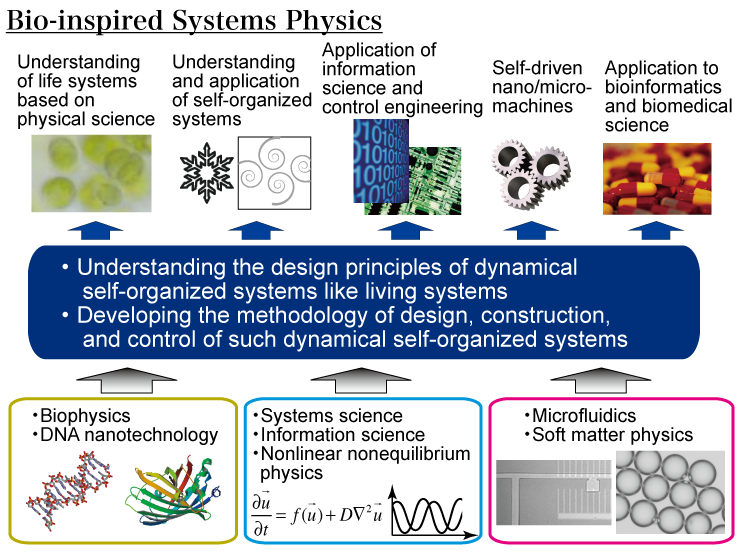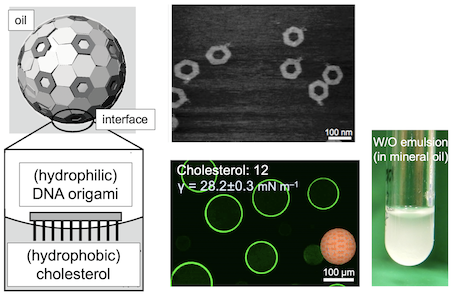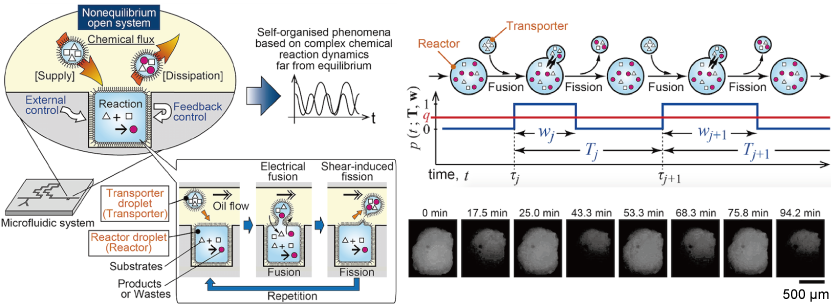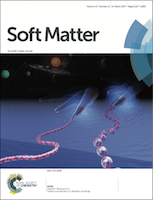Recent Highlights
Introduction
Our lab is studying in (1) Dept. Computer Science, (2) Dept. Life Science and Technology, and (3) Dept. Systems and Control Engengineering, Tokyo Tech
Bio-inspired Systems Physics
Our group is studying interdisciplinary research on DNA nanotechnology, artificial cell engineering, and molecular robotics based on experimental studies on bio soft matter physics, biophysics, biopolymer chemistry, and microfluidics combined with computer simulation study. More specifically, we study construction of artificial cells or artificial nuclei using DNA gels and DNA droplets; biophysical control of phase separation of biopolymers; soft matter physics of DNA, peptide, and emulsion; construction of DNA information device (molecular memory/storage, molecular computer, molecular robot) based on computational DNA sequence design; artificial cell engineering based on microfluidics. These studies are important for basic science of biophysics of higher-order molecular information systems such as DNA and chromatin, which are the essential part of biological information. Besides, these studies will be advantage for applied science to construct intelligent nanobio machines/computers that can be beyond the current biological functions. [Japanese page]
Keywords: Molecular robotics; DNA molecular computing; Artificial cell engineering; Microfluidics; Molecular computer science; Biophysics of programmable soft matter; Nonequilibrium science; Post-silicon biocomputing.

Admission
Students can join our lab as a master course student or a Ph.D. course student of Department of Computer Science, Department of Life Science and Technology, or Department of Systems and Control Engineering.
International Graduate Program (IGP) (A)
International Graduate Program (IGP) (B)
International Graduate Program (IGP) (C)
Recent achievements
News
- Labs spotlight in Department of Life Science and Technology – Takinoue Laboratory – [JP/EN]
- Newsletter of Department of Life Science and Technology [JP/EN]
Recent work
DNA droplet formed via liquid-liquid phase separationexhibits droplet fusion, droplet fission, and protein positioning control:
- “Sequence design-based control of DNA droplets formed from phase separation of DNA nanostructures”, arXiv, Preprint, (2019). link to arXiv; link to under consideration in Nature Commun. news_190617a_07

Pickering microemulsion based on DNA-origami nanoplate:
- “DNA Origami Nanoplate-Based Emulsion with Designed Nanopore Function”, Angew. Chem. Int. Ed., in press (2019). DOI: 10.1002/anie.201908392 Preprint in ChemRxiv. DOI: 10.26434/chemrxiv.7046495.v1 link

DNA-based artificial cytoskeleton for artificial cell-like systems:
- “DNA cytoskeleton for stabilizing artificial cells”, Proc. Natl. Acad. Sci. USA (PNAS), online, (2017). doi: 10.1073/pnas.1702208114. link Press release: [English]

Non-equilibrium artificial cell-like reactors based on droplet microfluidics:
- “Pulse-density modulation control of chemical oscillation far from equilibrium in a droplet open-reactor system”, Nature Commun. (2016). link Press release: [English]

- “A Bacterial Continuous Culture System Based on a Microfluidic Droplet Open Reactor”, Anal. Sci. (2016). link (awarded ‘Hot Article Award’ of this issue: link)
Centrifugal microfluidics for soft matter (microgels, droplets, artificial cells)
- Shoya Yasuda, Masayuki Hayakawa, Hiroaki Onoe, *Masahiro Takinoue, “Twisting microfluidics in a planetary centrifuge”, Soft Matter, 13(11), 2141-2147 (2017). doi:10.1039/C6SM02695H. link (highlighted as the front cover picture of the issue: link)
- “A Bacterial Continuous Culture System Based on a Microfluidic Droplet Open Reactor”, Anal. Sci. (2016). link (awarded ‘Hot Article Award’ of this issue: link)

- “Droplet-Shooting and Size-Filtration (DSSF) Method for Synthesis of Cell-Sized Liposomes with Controlled Lipid Compositions”, ChemBioChem (2015). link
- “Generation of Monodisperse Cell-Sized Microdroplets using a Centrifuge-Based Axisymmetric Co-Flowing Microfluidic Device”, J. Biosci. Bioeng. (2015). link
- “Complex-shaped three- dimensional multi-compartmental microparticles generated by diffusional and Marangoni microflows in centrifugally discharged droplets”, Sci. Rep. (2016). link
- Introduction in ‘Atlas of Science’: link
For students
- Message For Foreign Students
- Lab Photo Gallery (Japanese)
- Lab Member List
Contact
E-mail: takinoue (at) c.titech.ac.jp masahiro.takinoue (at) takinoue-lab.jp
